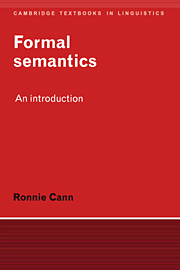Book contents
- Frontmatter
- Contents
- List of figures
- Preface
- List of symbols
- 1 INTRODUCTION
- 2 PREDICATES AND ARGUMENTS
- 3 NEGATION AND CO-ORDINATION
- 4 TYPE THEORY
- 5 THE LAMBDA OPERATOR
- 6 QUANTIFICATION
- 7 INFERENCE
- 8 TIME, TENSE AND ASPECT
- 9 POSSIBLE WORLDS
- 10 INTENSIONAL SEMANTICS
- Answers to selected exercises
- References
- Index
2 - PREDICATES AND ARGUMENTS
Published online by Cambridge University Press: 05 June 2012
- Frontmatter
- Contents
- List of figures
- Preface
- List of symbols
- 1 INTRODUCTION
- 2 PREDICATES AND ARGUMENTS
- 3 NEGATION AND CO-ORDINATION
- 4 TYPE THEORY
- 5 THE LAMBDA OPERATOR
- 6 QUANTIFICATION
- 7 INFERENCE
- 8 TIME, TENSE AND ASPECT
- 9 POSSIBLE WORLDS
- 10 INTENSIONAL SEMANTICS
- Answers to selected exercises
- References
- Index
Summary
Translating English into a logical language
In this chapter and the next, we will lay the foundations on which a good deal of logical semantics is built. In accordance with the discussion in Chapter 1, we first define a logical language into which sentences of English are translated in order to circumvent the problems of ambiguity and underdeterminacy found in the object language. Having defined the translation language, and specified the procedure for translating simple English sentences into it, our attention will turn to the interpretation of these logical expressions in terms of their truth-conditions, thus providing an indirect interpretation of the corresponding English sentences.
The syntax of LP
Like all languages, natural or artificial, logical languages have a syntax, i.e. a set of rules for constructing composite expressions from simpler ones. The logical language described in this chapter, called LP, contains expressions that fall into one of four logical categories: individuals, predicates, formulae and operators (or connectives). Expressions in each of the first three categories can be further subdivided into two sorts: constants, which have a fixed interpretation, and variables, which do not. These two sorts of expression correspond, roughly, to content words (e.g. table, run, Ethel) and pronominal expressions (e.g. she, they) in natural languages, respectively. This chapter deals only with constants, but variables will become increasingly important in later chapters.
Sentences in natural languages translate into formulae in LP which have the logical category t (as sentences have the syntactic category S).
- Type
- Chapter
- Information
- Formal SemanticsAn Introduction, pp. 27 - 53Publisher: Cambridge University PressPrint publication year: 1993



